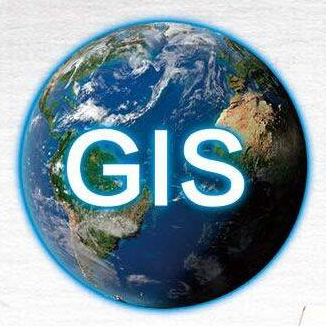Representative Publications (Top Five)
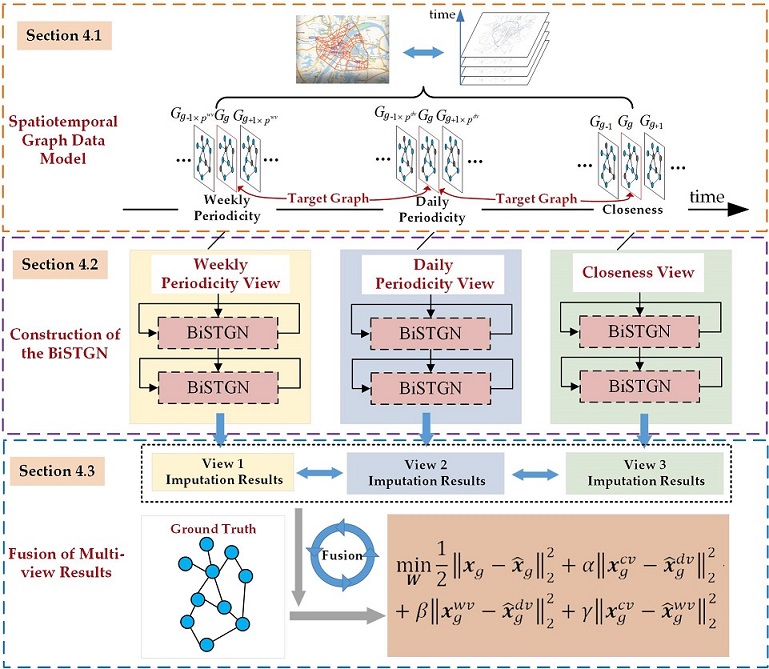
In this study, we propose a novel multi-view bidirectional spatiotemporal graph network called Multi-BiSTGN to impute urban traffic data with complex missing patterns.The proposed model was validated on real-world traffic datasets collected in Wuhan, China. Experimental results showed that Multi-BiSTGN outperformed ten existing baselines under different missing types (random missing, block missing, and mixed missing) and missing rates.
Peixiao Wang , Tong Zhang*, Yueming Zheng, and Tao Hu
2022,36(6):1231-1257. (Journal Paper, ESI Highly Cited Papers)
International Journal of Geographical Information Science (SSCI/SCI, GSC Rank T1, Latest JCR Q1, Latest CAS D1, Latest IF=5.1)
DOI: 10.1080/13658816.2022.2032081
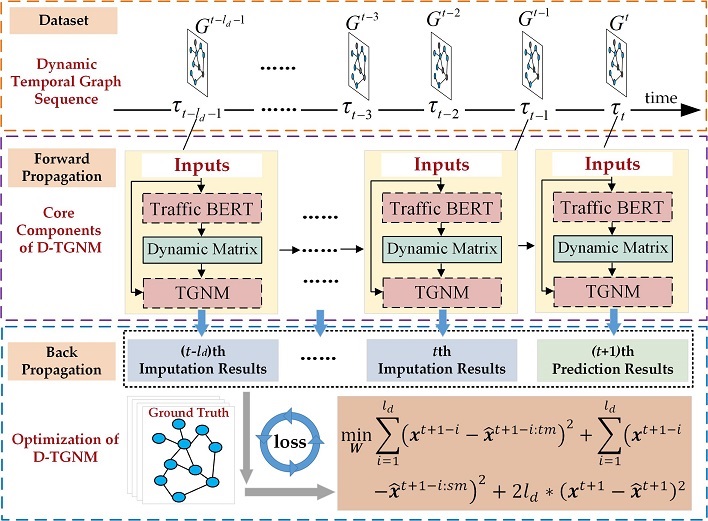
We proposed a dynamic temporal graph neural network for traffic flow prediction with missing values.The proposed model was validated on an actual traffic dataset collected in Wuhan, China. Experimental results showed that D-TGNM achieved good prediction results under four missing data scenarios, and outperformed ten existing state-of-the-art baselines.
Peixiao Wang , Yan Zhang, Tao Hu, and Tong Zhang*
2023,37(4):885-912. (Journal Paper)
International Journal of Geographical Information Science (SSCI/SCI, GSC Rank T1, Latest JCR Q1, Latest CAS D1, Latest IF=5.1)
DOI: 10.1080/13658816.2022.2146120
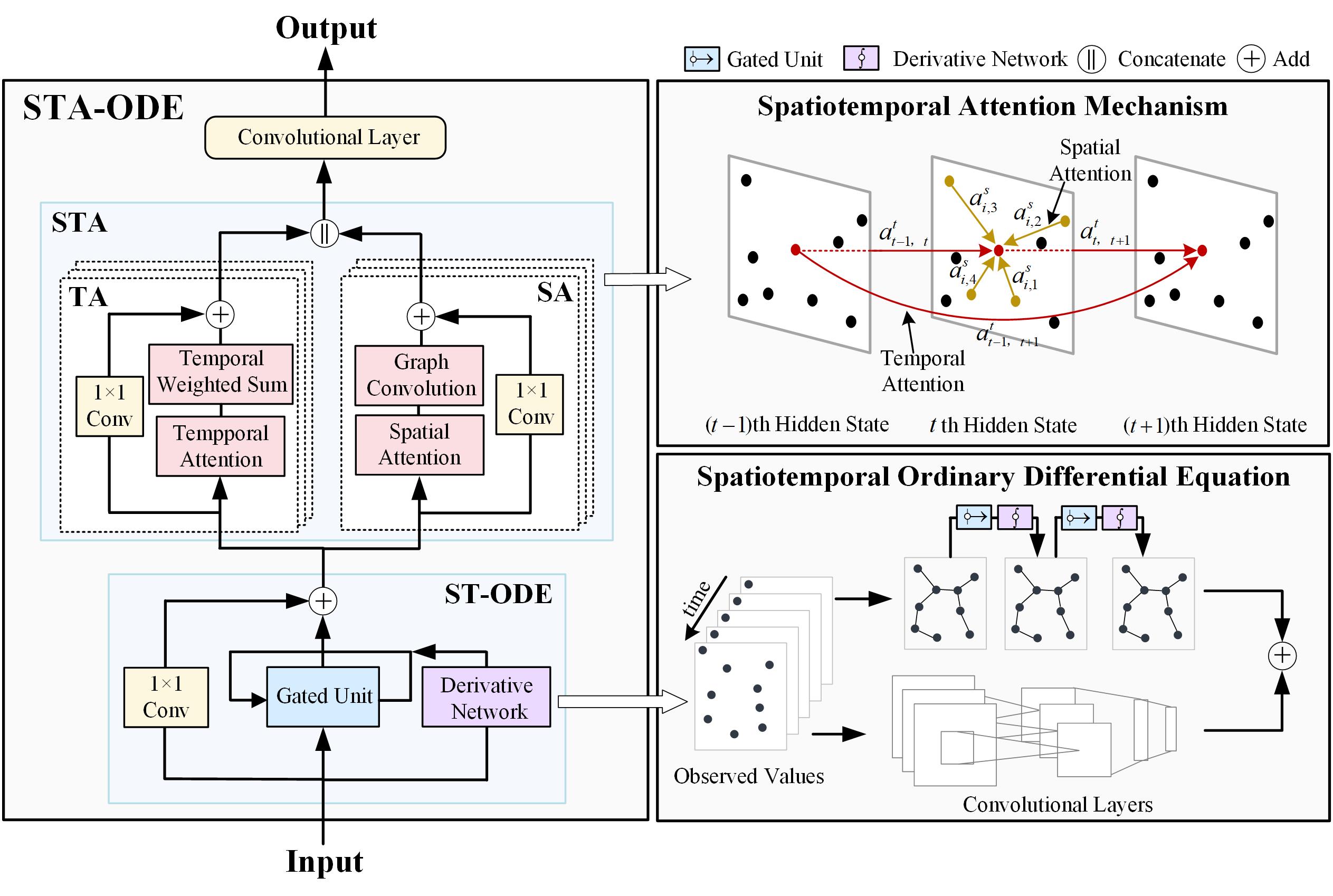
In this study, we propose a novel spatiotemporal attentional neural differential equation (STA-ODE) model for interpretable spatiotemporal prediction tasks.The proposed model was validated on three real-world spatiotemporal datasets. Experimental results showed that STA-ODE outperformed seven existing baselines in terms of prediction accuracy. In addition, we also demonstrated the good interpretation and good prediction accuracy of the STA-ODE model from the perspective of visualization.
Peixiao Wang , Tong Zhang*, Hengcai Zhang, Shifen Cheng, and Wangshu Wang
2024:38(1):156-181. (Journal Paper)
International Journal of Geographical Information Science (SSCI/SCI, GSC Rank T1, Latest JCR Q1, Latest CAS D1, Latest IF=5.1)
DOI: 10.1080/13658816.2023.2275160
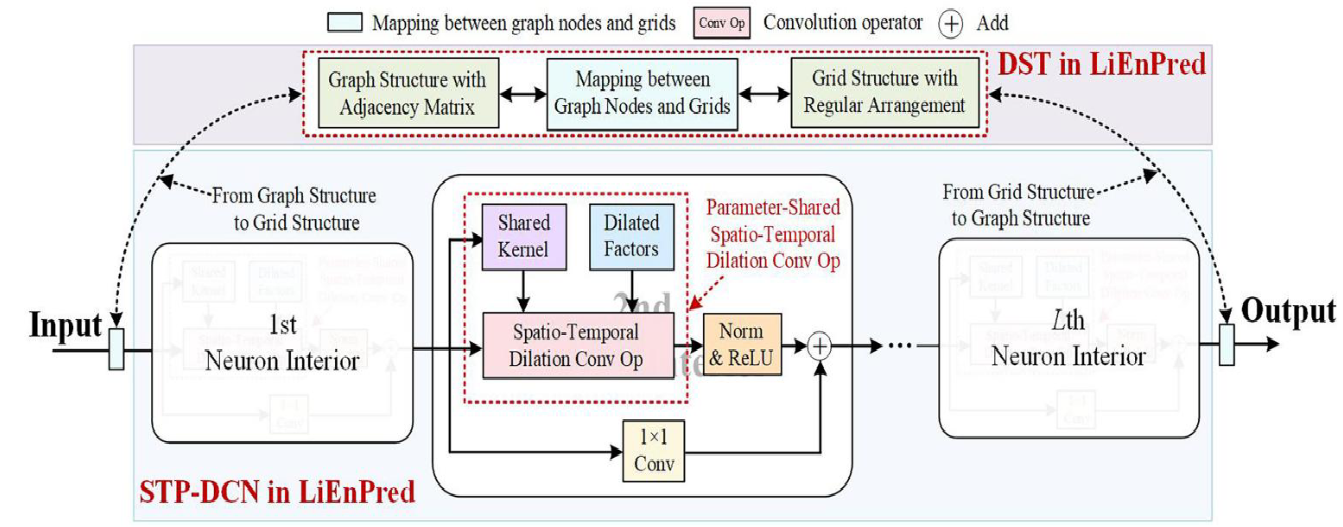
In this study, we propose a Lightweight Ensemble Predictor (LiEnPred) for efficient air quality prediction in large-scale sparse scenarios. In our experiments, we collected air quality data from over 2000 sensors across China over the past three years and evaluated LiEnPred’s prediction performance in large-scale scenarios using PM2.5 and NO2 concentration data. The experimental results demonstrate that the proposed LiEnPred model matches or exceeds the pre dictive accuracy of eight baselines with faster time efficiency and fewer model parameters.
Peixiao Wang , Hengcai Zhang*, Jie Liu, Tong Zhang, and Feng Lu
2025, 39(4):900-924. (Journal Paper)
International Journal of Geographical Information Science (SCI, CIC Rank T, Latest JCR Q1, Latest CAS D1 Top, Latest IF=5.1)
DOI: 10.1080/13658816.2024.2437044
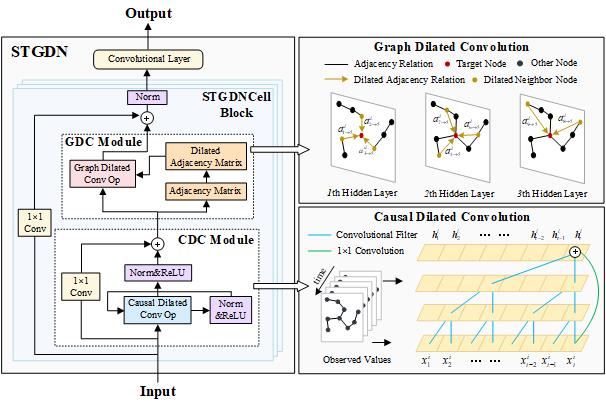
In this study, we propose a lightweight spatiotemporal graph dilated convolutional network called STGDN with satisfactory prediction accuracy and lower model complexity. We conducted on multi experiments on three real-world spatiotemporal datasets, and the experimental results show that the proposed STGDN model outperforms or achieves comparable prediction accuracy of the existing nine baselines with higher operational efficiency and fewer model parameters.
Peixiao Wang , Hengcai Zhang*, Shifen Cheng, Tong Zhang, Feng Lu and Sheng Wu
2024,101:105105. (Journal Paper)
Sustainable Cities and Society (SCI, ASC Rank T1, Latest JCR Q1, Latest CAS D1 Top, Latest IF=12)
DOI: 10.1016/j.scs.2023.105105
All Publications
2026 (*Corresponding Author, #Students under My Supervision):
[1] Cheng Zhong#, Sheng Wu, Peixiao Wang*, Hengcai Zhang, et al. Predicting Human Activity Intensity in Urban Areas with a Prior-Enhanced Probabilistic-Deterministic Model[J]. International Journal of Geographical Information Science, 2026. DOI:10.1080/13658816.2025.2562250. (SSCI/SCI, GSC Rank T1, Latest JCR Q1, Latest CAS D1, Latest IF=5.1)[Journal Paper]
[2] Jianing Yu, Hengcai Zhang*, Peixiao Wang, Feng Lu, et al. A geospatial skeleton framework for unveiling the 3D structure and dynamics of marine heatwaves from earth observation data[J]. Geo-spatial Information Science, 2026. DOI:10.1080/10095020.2025.2547069. (SCI, GSC Rank T2, Latest JCR Q1, Latest CAS D2, Latest IF=5.5)[Journal Paper]
2025 (*Corresponding Author, #Students under My Supervision):
[1] Peixiao Wang, Hengcai Zhang*, Jie Liu, Feng Lu, et al. Efficient inference of large-scale air quality using a lightweight ensemble predictor[J]. International Journal of Geographical Information Science, 2025, 39(4): 900-924. (SSCI/SCI, GSC Rank T1, Latest JCR Q1, Latest CAS D1, Latest IF=5.1)[Journal Paper]
[2] Peixiao Wang, Hengcai Zhang*, Shifen Cheng, et al. Quickly forecasting the future state of urban sensors by the missing-data-tolerant deep learning approach[J]. Sustainable Cities and Society, 2025, 118: 106044. (SCI, ASC Rank T1, Latest JCR Q1, Latest CAS D1 Top, Latest IF=12)[Journal Paper]
[3] Peixiao Wang, Hengcai Zhang*, Beibei Zhang, Shifen Cheng, et al. Spatiotemporal variations of private e-bike trips with explainable data-driven technologies[J]. Cities, 2025, 158:105712. (SSCI, GSC Rank T1, Latest JCR Q1, Latest CAS D1, Latest IF=6.6)[Journal Paper]
[4] Peixiao Wang, Haolong Yang, Hengcai Zhang*, et al. Lightweighting the prediction process of urban states with parameter sharing and dilated operations[J]. International Journal of Digital Earth, 2025,18:2468414. (SCI, GSC Rank T1, Latest JCR Q1, Latest CAS D2, Latest IF=4.9)[Journal Paper]
[5] Peixiao Wang, Hengcai Zhang*, Yan Zhang, Shifen Cheng, et al. GeoAI-driven Spatiotemporal Prediction: Progress and Prospects[J]. Journal of Geo-information Science, 2025, 27(1):60-82 (In Chinese). [王培晓, 张恒才*, 张岩, 程诗奋, 张彤, 陆锋. (2025). 地理空间智能预测研究进展与发展趋势. 地球信息科学学报, 27(1):60-82.] (EI, GSC Rank T2)[Journal Paper]
[6] Cheng Zhong#, Sheng Wu, Peixiao Wang*, Hengcai Zhang, et al. Prior- and Data-Guided Model for Predicting Urban Human Activity Intensity[J]. Journal of Geo-information Science, 2025, 27(10):2453-2465 (In Chinese). [钟诚#, 吴升, 王培晓*, 张恒才, 程诗奋, 陆锋. (2025). 先验与数据双引导的城市居民活动强度预测模型. 地球信息科学学报, 27(10):2453-2465.] (EI, GSC Rank T2)[Journal Paper]
[7] Feng Lu*, Shifen Cheng, Peixiao Wang. GeoAI enabled urban computing: status and challenges[J]. Annals of GIS, 2025, 31(4):537-555. (ESCI)[Journal Paper]
[8] Jianing Yu, Hengcai Zhang*, Peixiao Wang, Jinzi Wang, et al. Sequence Analysis of Local Indicators of Spatio-Temporal Association for Evolutionary Pattern Discovery[J]. GIScience and Remote Sensing, 2025, 62(1):2487292. (SCI, GSC Rank T1, Latest JCR Q1, Latest CAS D1, Latest IF=6.9)[Journal Paper]
[9] Yibo Zhao, Shifen Cheng*, Song Gao, Peixiao Wang, et al. Predicting origin-destination flows by considering heterogeneous mobility patterns[J]. Sustainable Cities and Society, 2025, 118: 106015. (SCI, ASC Rank T1, Latest JCR Q1, Latest CAS D1 Top, Latest IF=12)[Journal Paper]
[10] Peijie Sun, Hengcai Zhang*, Peixiao Wang, Jianing Yu. 3D-SHI index for quantifying 3D spatial heterogeneity in big Earth data[J]. International Journal of Digital Earth, 2025, 18: 2512058. (SCI, GSC Rank T1, Latest JCR Q1, Latest CAS D2, Latest IF=4.9)[Journal Paper]
[11] Zhipeng Wang, Tong Zhang*, Jing Li,Peixiao Wang, et al. Capturing spatial heterogeneity of population-level human mobility via a prior-guided graph neural network[J]. International Journal of Geographical Information Science, 2025, 39(12):2710-2737. (SSCI/SCI, GSC Rank T1, Latest JCR Q1, Latest CAS D1, Latest IF=5.1)[Journal Paper]
[12] Maoqi Lun#, Peixiao Wang, Sheng Wu*, Hengcai Zhang, et al. Predicting the Next Location of Urban Individuals Via a Representation-Enhanced Multi-View Learning Network[J]. ISPRS International Journal of Geo-Information, 2025, 14(8): 302. (SCI, GSC Rank T3, Latest JCR Q2, Latest IF=3.1)[Journal Paper]
[13] Zhoushun Han, Hengcai Zhang*, Jinzi Wang, Xin Fu, Peixiao Wang, et al. A high-resolution 3D emissions inventory of airport and its hotspot detection: A case study of Beijing Capital International Airport, China[J]. Journal of Cleaner Production, 2025, 145698. (SCI, Latest JCR Q1, Latest CAS D1, Latest IF=10)[Journal Paper]
[14] Zhongyi Wang, Hengcai Zhang*, Peixiao Wang, et al. Analyzing Dynamic Spatiotemporal Heterogeneity in Chinese Airport Delay Patterns[J]. Acta Geographica Sinica, 2025, 80(2): 490-502(In Chinese). [王中一, 张恒才*, 王培晓, 於佳宁, 康永伟. (2025). 中国机场延误模式动态时空异质性分析. 地理学报, 80(2): 490-502] (EI, GSC Rank T1)[Journal Paper]
[15] Jie Liu, Tong Zhang*, Peixiao Wang, et al. Rainstorm prediction using "estimation-correction" recurrent network[J]. Geo-Information Science, 2025, 27(4): 888-899(In Chinese). [刘杰, 张彤*, 王培晓, 韩士元, 冷亮, 肖艳姣. (2025). 基于卡尔曼"估计-校正"循环网络的暴雨临近预测. 地球信息科学学报, 27(4): 888-899] (EI, GSC Rank T2)[Journal Paper]
2024 (*Corresponding Author):
[1] Peixiao Wang, Tong Zhang*, et al. Adding attention to the neural ordinary differential equation for spatio-temporal prediction[J]. International Journal of Geographical Information Science, 2024, 38(1):156-181. (SSCI/SCI, GSC Rank T1, 2024 JCR Q1, 2024 CAS D1, 2024 IF=5.1)[Journal Paper]
[2] Peixiao Wang, Hengcai Zhang*, et al. A lightweight spatiotemporal graph dilated convolutional network for urban sensor state prediction[J]. Sustainable Cities and Society, 2024, 101:105105. (SCI, ASC Rank T1, 2024 JCR Q1, 2024 CAS D1 Top, 2024 IF=12)[Journal Paper]
[3] Peixiao Wang, Hengcai Zhang*, Shifen Cheng, Feng Lu, Tong Zhang, and Zeqiang Chen. Understanding human mobility and trip demand through sparse trajectories of private e-bikes[J].Journal of Cleaner Production,2024, 471:143444.(SCI, 2024 JCR Q1, 2024 CAS D1 Top, 2024 IF=10)[Journal Paper]
[4] Peixiao Wang, Tong Zhang*, and Tao Hu. Traffic condition estimation and data quality assessment for signalized road networks using massive vehicle trajectories[J].Journal of Ambient Intelligence and Humanized Computing,2024, 15(1):305–322.(EI)[Journal Paper]
[5] Peixiao Wang, Hengcai Zhang*, Tong Zhang, Feng Lu. An attentional ordinary differential equation for predicting PM2.5 concentration and its interpretability analysis[J]. Geo-Information Science, 2024, 26(6):1363-1373 (in Chinese). [王培晓, 张恒才*, 张彤, 陆锋. (2024). 基于注意力常微分方程的PM2.5浓度预测及其可解释性分析. 地球信息科学学报, 26(6):1363-1373] (EI, GSC Rank T2) [Journal Paper]
[6] Peixiao Wang, Hengcai Zhang*, Feng Lu. Predicting Future Spatio-Temporal States Using a Robust Causal Graph Attention Model[C]. Spatial Data and Intelligence, Singapore: Springer Nature, 2024: 242-251. (EI) [Conference Paper]
[7] Peixiao Wang. Missing imputation and short-term prediction of urban traffic flow based on spatiotemporal view learning[J]. Acta Geodaetica et Cartographica Sinica, 2024, 53(10):2037 (in Chinese). [王培晓. (2024). 时空视图学习支持的城市交通数据缺失补全与短期预测. 测绘学报, 53(10):2037] (EI, GSC Rank T1) [Journal Paper]
[8] Tong Zhang, Jie Liu*, Chulin Gao, Peixiao Wang, el at. Prior-Guided Gated Convolutional Networks for Rainstorm Forecasting[J]. Journal of Hydrology, 2024. 633: 130962. (SCI, 2024 JCR Q1, 2024 CAS D1 Top, 2024 IF=6.3)[Journal Paper]
[9] Lin Cong, Hengcai Zhang*, Peixiao Wang, el at. Impact of the Russia-Ukraine Conflict on Global Marine Network Based on Massive Vessel Trajectories[J]. Remote Sensing, 2024. 16(8): 1329. (SCI, 2024 JCR Q1, 2024 CAS D2, Latest IF=4.1)[Journal Paper]
[10] Chen Chu, Hengcai Zhang*, Peixiao Wang, Feng Lu. Simulating human mobility with a trajectory generation framework based on diffusion model[J]. International Journal of Geographical Information Science, 2024, 38(5):847-878. (SCI/SSCI, 2024 JCR Q1, 2024 CAS D1, 2024 IF=5.1)[Journal Paper]
[11] Shifen Cheng, Lizeng Wang, Peixiao Wang, el at. An ensemble spatial prediction method considering geospatial heterogeneity[J]. International Journal of Geographical Information Science, 2024, 2024, 38(9):1856-1880. (SCI/SSCI, 2024 JCR Q1, 2024 CAS D1, 2024 IF=5.1)[Journal Paper]
[12] Beibei Zhang, Shifen Cheng*, Peixiao Wang, Feng Lu. Inferring freeway traffic volume with spatial interaction enhanced betweenness centrality[J]. International Journal of Applied Earth Observation and Geoinformation, 2024. 129: 103818. (SCI, 2024 JCR Q1, 2024 CAS D1 Top, 2024 IF=8.6)[Journal Paper]
[13] Tong Zhang, Jianlong Wang, Tong Wang, Yiwei Pang, Peixiao Wang, el at. A deep marked graph process model for citywide traffic congestion forecasting[J]. Computer-Aided Civil and Infrastructure Engineering, 2024, 39(8):1180-1196. (SCI, ASC Rank T1, 2024 JCR Q1, 2024 CAS D1 Top, 2024 IF=9.1)[Journal Paper]
[14] Jinhui Peng, Gongkai Zhang, Tong Wang, Peixiao Wang, and Tong Zhang*. A Trajectory-Driven Multi-Layer Spatiotemporal Graph Neural Network for Predicting Short-Term Urban Traffic State[J]. Geo-Information Science, 2024, 26(10):2300-2315 (in Chinese). [彭锦辉, 张功凯, 王彤, 王培晓, 张彤*. (2024). 轨迹驱动的多层时空图神经网络交通路况短期预测. 地球信息科学学报, 26(10):2300-2315.] (EI, GSC Rank T2) [Journal Paper]
[15] Jianlong Wang, Xiaoqi Duan*, Peixiao Wang, A-Gen Qiu, and Zeqiang Chen. Predicting Urban Signal-Controlled Intersection Congestion Events Using Spatio-Temporal Neural Point Process[J]. International Journal of Digital Earth, 2024, 17(1):2376270. (SCI, 2024 JCR Q1, 2024 CAS D2, GSC Rank T2, 2024 IF=4.9) [Journal Paper]
2023 (*Corresponding Author):
[1] Peixiao Wang, Yan Zhang, Tao Hu, Tong Zhang*. Urban traffic flow prediction: a dynamic temporal graph network considering missing values[J]. International Journal of Geographical Information Science, 2023, 37(4):885-912. (SSCI/SCI, GSC Rank T1, 2023 JCR Q1, 2023 CAS D1, 2023 IF=4.3)[Journal Paper]
[2] Peixiao Wang , Tong Zhang*, Shichao Nie, el at. A Causal Graph Convolutional Network Considering Missing Values for Spatiotemporal Prediction[J]. Acta Geodaetica et Cartographica Sinica, 2023,52(5): 818-830 (in Chinese). [王培晓 , 张彤*, 聂士超, 杨瑾萱, 王天骄. (2023). 顾及缺失值的因果图时空预测网络. 测绘学报, 52(5): 818-830] (EI, GSC Rank T1) [Journal Paper]
[3] Tong Zhang*, Renyu Liu, Peixiao Wang , et al. Physics-informed Machine Learning and Its Research Prospects in GeoAI[J]. Geo-Information Science, 2023,25(7):1297-1311. (in Chinese). [张彤*, 刘仁宇, 王培晓, 高楚林, 刘杰,王望舒. (2023). 感知物理先验的机器学习及其在地理空间智能中的研究前景. 地球信息科学学报, 25(7):1297-1311.] (EI, GSC Rank T2)[Journal Paper]
[4] Jie Liu, Tong Zhang*, Chulin Gao, and Peixiao Wang. Forecasting Earthquake Magnitude and Epicenter by Incorporating Spatio-temporal Priors into Deep Neural Networks[J]. IEEE Transactions on Geoscience and Remote Sensing, 2023, 61:1-13, Art no. 5911413. (SCI, GSC Rank T1, 2023 JCR Q1, 2023 CAS D1 Top, Latest IF=7.5) [Journal Paper]
[5] Chen Chu, Hengcai Zhang*, Peixiao Wang, Feng Lu. DeepIndoorCrowd: Predicting crowd flow in indoor shopping malls with an interpretable transformer network[J]. Transactions in GIS, 2023, 27(6): 1699-1723. (SSCI, GSC Rank T2, 2023 JCR Q2, 2023 CAS D3, 2023 IF=2.1)[Journal Paper]
2022 (*Corresponding Author):
[1] Peixiao Wang, Tong Zhang*, et al. A multi-view bidirectional spatiotemporal graph network for urban traffic flow imputation[J]. International Journal of Geographical Information Science, 2022, 36(6):1231-1257. (SSCI/SCI, GSC Rank T1, 2022 JCR Q1, 2022 CAS D2, 2022 IF=5.7)[Journal Paper]
[2] Peixiao Wang, Tao Hu, Fei Gao, Ruijie Wu, Wei Guo*, et al. A Hybrid Data-Driven Framework for Spatiotemporal Traffic Flow Data Imputation[J]. IEEE Internet of Things Journal, 2022, 9(17):16343-16352. (SCI, CIC Rank T, 2022 JCR Q1, 2022 CAS D1 Top, 2022 IF=10.7)[Journal Paper]
[3] Peixiao Wang, Tao Hu*, Hongqiang Liu, et al. Exploring the impact of under-reported cases on the COVID-19 spatiotemporal distributions using healthcare workers infection data. Cities, 2022, 123:103593.(SSCI, GSC Rank T1, 2022 JCR Q1, 2022 CAS D1 Top, 2022 IF=6.7)[Journal Paper]
2021 (*Corresponding Author):
[1] Peixiao Wang, Hui Ren, Xinyan Zhu*, et al. Spatiotemporal Characteristics and Factor Analysis of SARS-CoV-2 Infections among Healthcare Workers in Wuhan, China[J].Journal of Hospital Infection , 2021, 110: 172-177. (SCI, 2021 JCR Q1, 2021 CAS D3, 2021 IF=8.944)[Journal Paper]
[2] Peixiao Wang, Sheng Wu, Hengcai Zhang*, el at. A Method for Identifying Spatial and Temporal Aggregation Area of Indoor Crowd[J]. Geomatics and Information Science of Wuhan University, 2021,46(5):790-798 (in Chinese). [王培晓, 吴升, 张恒才*, 陆锋, 王宏恩. (2021). 一种室内人群时空聚集区域识别方法. 武汉大学学报信息科学版, 46(5):790-798] (EI, GSC Rank T2) [Journal Paper]
[3] Peixiao Wang, Xinyan Zhu*, Wei Guo, el at. Spatiotemporal Differences of COVID-19 Infection Among Healthcare Workers and Patients in China From January to March 2020[J]. IEEE Access, 2021,9:28646-28657. (SCI, 2021 JCR Q2, 2021 CAS D3, 2021 IF=3.476) [Journal Paper]
[4] Tao Hu, Siqin Wang, Bing She, Mengxi Zhang, Xiao Huang, Yunhe Cui, Jacob Khuri, Yaxin Hu, Xiaokang Fu, Xiaoyue Wang, Peixiao Wang, el at.Human mobility data in the COVID-19 pandemic: characteristics, applications, and challenges[J]. International Journal of Digital Earth,2021,14(9):1126-1147. (SCI, GSC Rank T1, 2021 JCR Q1, 2021 JCR D2, 2021 IF=4.606)[Journal Paper]
[5] Hui Ren, Peixiao Wang , Wei Guo*, el at.Exploring the Spatiotemporal Characteristics of COVID-19 Infections among Healthcare Workers: A Multi-Scale Perspective[J]. ISPRS International Journal of Geo-Information, 2021,10(10):691. (SCI, GSC Rank T3, 2021 JCR Q2, 2021 JCR D3, 2021 IF=3.099)[Journal Paper]
[6] Xin Fu, Hengcai Zhang*, and Peixiao Wang. Automatic Construction of Indoor 3D Navigation Graph from Crowdsourcing Trajectories[J]. ISPRS International Journal of Geo-Information, 2021,10(3):146. (SCI, GSC Rank T3, 2021 JCR Q2, 2021 IF=3.099)[Journal Paper]
2020 (*Corresponding Author):
[1] Peixiao Wang, Sheng Wu, and Hengcai Zhang*. Predicting Indoor Location based on a Hybrid Markov-LSTM Model[C]. //The 18th International Symposium on Web and Wireless Geographical Information Systems,Springer,2020:33-38. (EI) [Conference Paper]
[2] Peixiao Wang, Fei Gao, Yuhui Zhao, Ming Li, Xinyan Zhu*. Detection of Indoor High-Density Crowds via Wi-Fi Tracking Data[J]. Sensors, 2020, 20(18): 5078. (SCI, 2020 JCR Q2, 2020 CAS D2 Top, 2020 IF=3.576) [Journal Paper]
[3] Tao Hu, Weihe Wendy Guan, Xinyan Zhu, Yuanzheng Shao, Lingbo Liu, Jing Du, Hongqiang Liu, Huan Zhou, Jialei Wang, Bing She, Luyao Zhang, Zhibin Li, Peixiao Wang, el at. Building an Open Resources Repository for COVID-19 Research[J]. Data and Information Management, 2020,4(3):130-147.[Journal Paper]
2019 (*Corresponding Author):
[1] Peixiao Wang, Hengcai Zhang, Haibo Wang, Sheng Wu*. Spatial-temporal clustering by fast search and find of density peak[J]. Acta Geodaetica et Cartographica Sinica, 2019,48(11):1380-1390 (in Chinese). [王培晓, 张恒才, 王海波, 吴升*. (2019). ST-CFSFDP:快速搜索密度峰值的时空聚类算法. 测绘学报, 48(11):1380-1390] (EI, GSC Rank T1) [Journal Paper]
[2] Peixiao Wang, Sheng Wu, Hengcai Zhang*, el at. Indoor Location Prediction Method for Shopping Malls Based on Location Sequence Similarity[J]. ISPRS International Journal of Geo-Information, 2019,8(11):517. (SCI, GSC Rank T3, 2019 JCR Q3, 2019 CAS D1, 2019 IF=2.239) [Journal Paper]
[3] Peixiao Wang, Hongen Wang, Hengcai Zhang*, el at. A Hybrid Markov and LSTM Model for Indoor Location Prediction[J]. IEEE Access, 2019,7(1):185928-185940. (SCI, 2019 JCR Q1, 2019 CAS D2, 2019 IF=3.745) [Journal Paper]
[4] Mengying Fu, Peixiao Wang, Hengcai Zhang*, el at. A Crowdsourcing Method for Indoor Navigation Network[J]. Journal of Geomatics Science and Technology, 2019, 36(01): 100-104 (in Chinese). [傅梦颖, 王培晓, 张恒才*, 吴升. (2019). 一种室内导航网络众包构建方法. 测绘科学技术学报, 36(01): 100-104.] (GSC Rank T2) [Journal Paper]
[5] Mengying Fu, Hengcai Zhang*, Peixiao Wang, el at. A Method for Constructing Indoor Navigation Networks based on Moving Object Trajectory[J]. Geo-Information Science, 2019, 21(5): 631-640 (in Chinese). [傅梦颖, 张恒才*, 王培晓, 吴升, 陆锋. (2019). 基于移动对象轨迹的室内导航网络构建方法. 地球信息科学学报, 21(5): 631-640. ] (EI, GSC Rank T2) [Journal Paper]
2018 (*Corresponding Author):
[1] Peixiao Wang, Haibo Wang, Mengying Fu, Sheng Wu*. Research on Semantic Location Prediction of Indoor Users[J]. Geo-Information Science, 2018, 20(12): 1689-1698 (in Chinese). [王培晓, 王海波, 傅梦颖, 吴升*. (2018). 室内用户语义位置预测研究. 地球信息科学学报, 20(12): 1689-1698.] (EI, GSC Rank T2) [Journal Paper]
Note:Journal Citation Reports (JCR), Chinese Academy of Sciences (CAS), The Geographical Society of China (GSC), China Institute of Communications (CIC), Architectural Society of China (ASC), Journal Citation Reports (JCR)
All Patents
[1] 汤玲, 王培晓. 一种面向大尺度稀疏采样场景的空气质量快速预测方法和装置. 中国. 2025-11-11. ZL2024114286972. 发明专利.
[2] 程诗奋, 罗霄月, 王培晓, 陆锋. 一种异质性引导的交通流量补全方法、系统、介质和设备. 中国. 2025-07-01. ZL2025103531227. 发明专利.
[3] 程诗奋, 王立增, 王培晓, 陆锋. 一种顾及空间异质性的集成空间预测方法. 中国. 2024-06-07. ZL2024103306493. 发明专利.


